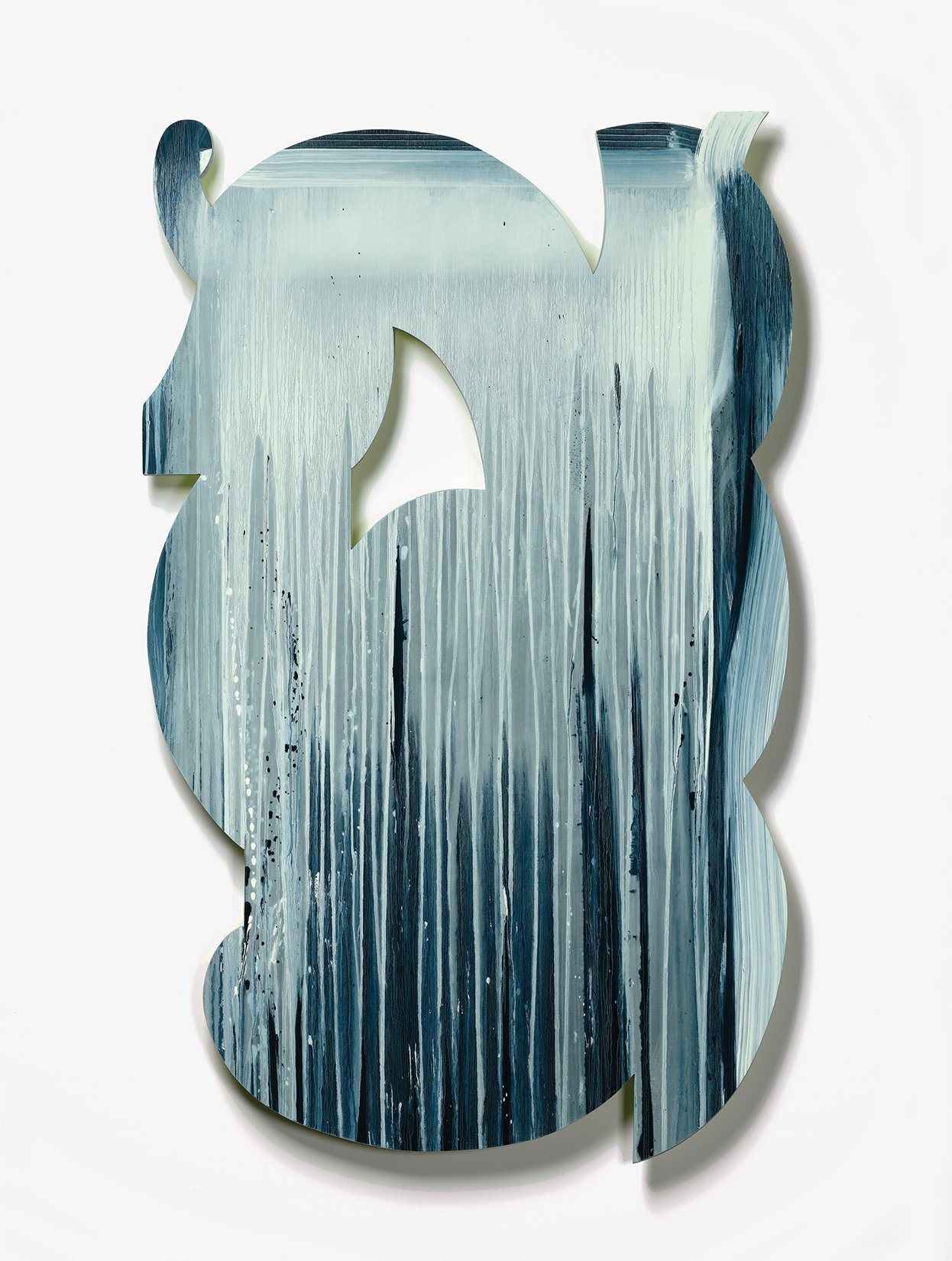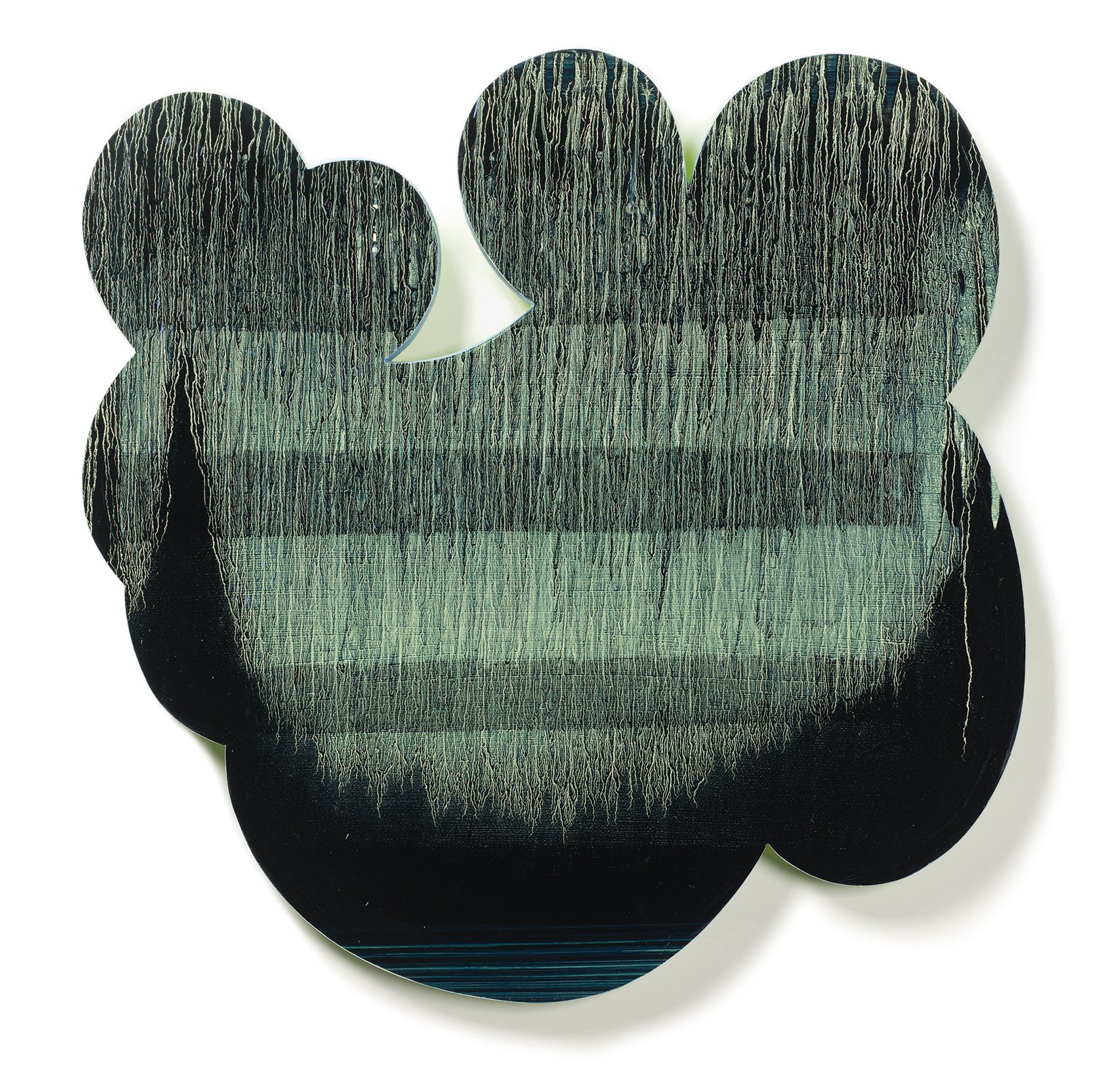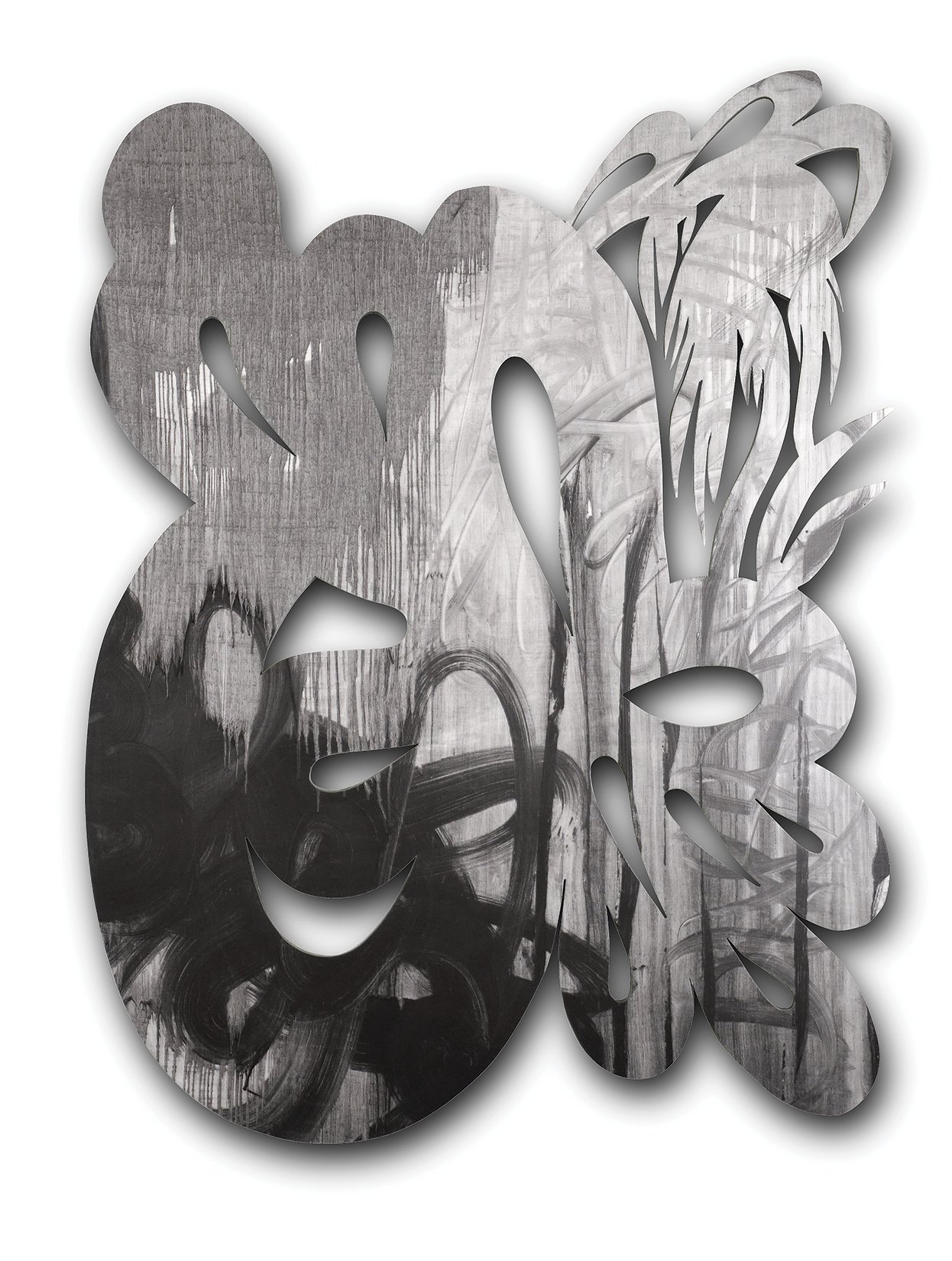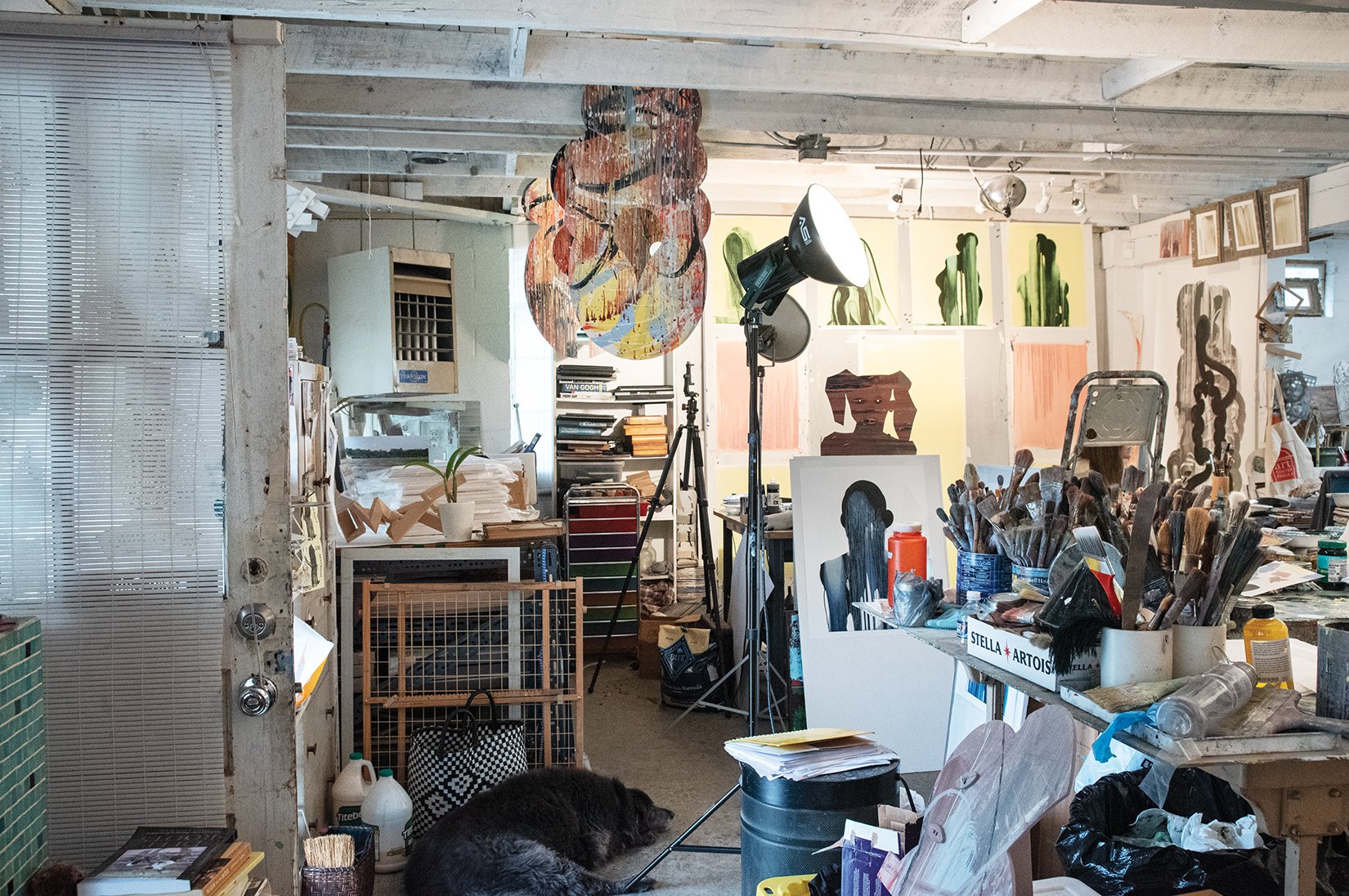Betsy Cain’s studio. Photo by Emily Earl.
When asked to outline her trajectory as an artist from her childhood in Tuscaloosa, Alabama, to her current career as one of the grand dames of the Savannah art scene, Betsy Cain reluctantly obliged. She told me about her early dreams of becoming a fashion designer — “Can you believe that?” she laughed, gesturing to her paint-splattered studio ware — and then told me about getting kicked out of the University of Auburn sneaking into her painting studio after-hours. “Women couldn’t wear pants, you know,” she said.
But Cain quickly grew tired of talking about her early years. “We’re not really going to go through all this, are we?” she asked in her soft and honeyed voice when pressed to remember some of the essential things she learned in college.
It was her elegant way of telling me that she didn’t have time for any bullshit. She does, after all, have a career that has lasted more than four decades to attend to.
Chastised, I barreled ahead, and asked her how her current practice evolved. It began, she said, when she moved with her husband, David Kaminsky, to Savannah in 1981. He had taken a teaching position in the photography department at a neophyte art college known as the Savannah College of Art and Design (SCAD). The pair were assigned to live in the girls’ housing, where they served as “dorm parents.” Free from quotidian concerns, Cain had no plans except to work as an artist. It was all that she could imagine doing with her life.
After graduating University of Alabama with both a BFA and MFA in painting, Cain had spent a year working, with the aid of a national grant, at the Art Center in Roswell, New Mexico. “That’s where I really learned how to flesh out myself as an artist in terms of a studio practice,” she says. She loved being surrounded by other artists, who taught her how to dig into her consciousness and really pursue the ideas that she found there. “That’s all I’ve ever wanted to do since,” she said, noting that David believes the experience “ruined her.” Ruined her, at least, for a life lived on someone else’s terms.
Savannah, in the early 1980s, had a scene of local artists, including John Earl, Jack Leigh and Gary Miller. There were a few quirky galleries, and a fierce competition between Myrtle Jones and Anne Taylor Nash, local artists whom Cain described as the “matriarchs of Savannah.” But beyond these avenues, it was difficult to “make it” as an artist. In order to be seen, Cain had to sell work straight out of her studio. But it was worth it, especially considering that real estate in the city was still cheap – Cain remembers many of the gorgeous downtown mansions being boarded up against looters – and studios were readily available. Cain worked in many different spaces, including a loft overlooking River Street; a vast space on the top floor of Preston Hall, a former armory that became SCAD’s first building; and her current studio on Bonaventure Road, where if she wants, she can stand outside amidst the Spanish moss and witness the parade of tourists headed to visit Bonaventure Cemetery.
Cain arrives at her studio at 11am every morning. She’s an early bird who rises before the sun, but these days, she reserves the mornings for contemplation, watching the sun rise over the marshes behind her cottage on Wilmington Island. With the exception of a brief stint as an art school teacher at the Savannah public schools, Cain has never known any other life beyond that of the studio. She was “ruined” in New Mexico, and then, she became a full-time working artist. The relative affordability of Savannah – until recently – allowed that kind of lifestyle.
Betsy Cain in her Bonaventure Road studio. Photo by David Kaminsky.
Cain considers her studio to be a contextual environment where all her experimentations with materials interact. Occasionally, an experiment blossoms into an artwork. On the day that she invited me to visit her, I sat on a low stool, petting her large black dog. When I leaned in to listen more closely to what she was saying, I noticed that there was a mask of Flannery O’Conner’s face hanging on the wall beside her. It rested beside a sort of quilt made up of paint splattered drop cloths, which Cain had arranged in a sort of two-dimensional ziggurat. I asked Cain if O’Conner’s short stories influenced her own work, and she responded that the gothic nature of it does. “Without Flannery O’Conner, we wouldn’t have any insight into racism in the South,” she says, noting that prejudices need to be personified so that they aren’t perceived as dead or forgotten. “It’s not in the past at all,” she adds.
The stories of the place she calls her home very much influence her work. One of her primary materials is indigo paint, which she uses to make paintings on yupo paper, a plasticized material that Cain says is “flat and bright.” “Indigo is a color that really captivates me,” she says. In the early 1990s, Cain watched the film Daughters of the Dust (1991), which is about three generations of Gullah women preparing to migrate from St. Helena Island to the North in 1902. St. Helena is about fifty miles northeast of Savannah and has a similar coastal landscape of tidal saltwater marshes. In the film, which was the first by a Black female director ever distributed in the United States, the women outline their family’s history working on the area’s indigo plantations. “The whole idea of the barrier islands and the plantations that were here, it made me understand that there is this really entrenched [indigo] color that is associated with the lowcountry,” Cain says of her experience watching the film.
Color is important, but most of Cain’s experimentations begin with the human figure. Over the course of her career, which has spanned more than four decades, Cain has veered both towards and away from literal representations of the human body. Lately, she’s landed somewhere in between them – suggesting, but not accurately portraying it. “I like the indistinctness of suggesting the figurative form in movement and in relationship to landscape,” she says. “The human body is so well known to each one of us. We read the figure so well.” For a long time, this familiarity made the human figure too intimidating to her, so she veered towards abstraction. Lately, she’s been feeling more courageous, and is contemplating a series of self-portraits, as well as portraits of people she knows well, including a man who does yard work on her property in Wilmington Island, and whom she refers to as a “back of the island boy.”
To the left of where we were sitting was a series of slick indigo paintings on yupo paper that suggested the curved shoulders and hunched form of a female body. Redolent of the cutouts of Kara Walker, as well as the abstract paintings of Pat Steir, the paintings could equally be read as representations of live oak trees dripping with Spanish moss in the dead of night as they could be figures of women whose color depths suggested entire lives. Dance, which Cain has seen as a spectator in New York, and now watches on Instagram, is also an inspiration. “There’s a choreography to my lines,” she says. “I’m creating something even if I don't really know what I’m doing at the time.”
Left: yellow green spring #4, 2023. Oil on yupo paper, 26 x 20 inches, framed. Courtesy of Laney Contemporary and the artist. Right: yellow green spring #5, 2023. Oil on yupo paper, 26 x 20 inches, framed. Courtesy of Laney Contemporary and the artist.
As our conversation meandered, Cain stood up, and began walking me around the studio. Almost every available surface was covered with materials. There were stacks of paper plates; sheets of color templates; catalogs from Cain’s past exhibitions; tubes of paint and buckets of plaster; and of course, many of Cain’s finished and in process artworks. Walking as close as she could possibly get to the surface of one of her indigo paintings, Cain pointed out how she carved ribbons onto its surface with razor blades. She frequently intervenes in this way in her paintings. Yupo paper consists of many layers. Cain discovered this when she tried to remove a blob of paint, and realized that the top-most, painted material of the paper could be lifted off. “I call these shreds,” she said, lifting the ribbons on the painting between her fingers. “They have movement, which I like.”
Cain’s interventions into her paintings are not always so discrete. Early in her career, she began cutting out photographs from National Geographic magazine. (When asked why, she responded, “Pictures, people, landscapes.”) She would cut out a shape from the image, and then fold it to create a sort of Rorschach test for whomever viewed it. “I got very into that because it was meditative,” she says. Cain liked that the shapes she cut out worked both for and against a clear reading of the image. She began to wonder what would happen if she did something similar with her paintings — cut shapes out of them once they were finished. “You could get some of the information from the original, but they’d tell an entirely new story,” she said.
Cut-outs have since become an important part of her practice. In a way, they can be read as Cain’s way of taking control over the figures she depicts, and deciding, as their creator, what their story will be. Cain says that the process of creating them is akin to taking a cookie cutter to one of her paintings, and then cutting out a shape. The cut-outs, which she carves after careful planning with a jigsaw blade, will be the highlight of Cain’s next major exhibition — a booth hosted by Laney Contemporary at the Future Fair in New York in early May. Fellow Savannah artist Katherine Sandoz will also be exhibiting recent paintings, all of which relate to the lowcountry landscape.
Although the cut-outs have more sophistication than ink blots on the paper, their abstract forms still serve as Rorschach tests. The one most visible on the day that I visited Cain’s studio was rendered in hues of green and looked like a Shamrock to me. St. Patrick’s Day had just passed in Savannah, and I was still overwhelmed by how enthusiastically the holiday is celebrated in comparison to other places I’ve lived, including New York. (It’s worth noting that I’m almost 100% Irish by descent, and attended the parade in New York for almost every of the 38 years I lived in the city.) When I told that to Cain, who had warmed up a bit to me since my initial round of inane questioning, she laughed. “That’s from the base of a large cut-out called ‘dusk grapes,’” she said.
Even though the studio is not on the water, the marshes of the lowcountry are everywhere. Into the marshes, Cain looks deeply, and sees all the negative spaces cut out between the marsh grass, the mud, the brackish water of the rivers, and the sky itself, which puffs up angrily in the heat, unleashing thunder. “They have energy and text and light and significance,” she says.
Cain first became interested in the marshes in the 1980s, when she was still new to Savannah. She noticed a kayak on the roof of a passing car, and decided she wanted to try the sport herself. “Getting out on the water was really what I needed,” she says. Cain first fell in love with the landscape of the lowcountry during childhood trips from Tuscaloosa to Gulf Shores, where her family spent holidays. In the early 1990s, she adopted the landscape permanently, moving from a place in downtown Savannah to her little cottage out on Wilmington Island where she and David still live today.
The cottage, which backs onto the marsh, offers constant inspiration — and heartache. When a neighbor built a 980-foot dock off his property, it interrupted the thriving ecosystem of the river. The vast structure began trapping wrack, a dead plant material that collects when the marsh grasses die at the end of autumn. The wrack eventually spread out over seven acres of land, suffocating the ecosystem beneath it, and preventing new grass, which serves as food and shelter for many species, from growing back. Recently, Cain went out with some neighbors, and pushed the wrack down the river with her bare hands.
The lowcountry not only inspires many series of work – in the back corner of the studio where we ended our conversation, Cain showed me drawings she had made after a recent trip to Ossabaw Island – but it also is the template she uses to connect with those she loves. When her best friend, Jane Fishman, a local writer, was diagnosed with cancer, and began undergoing chemotherapy, Cain would go out into her backyard every morning and take a photograph. She sent a daily photograph to Fishman until she died in 2022. Over the past few years, she’s added to the list of daily recipients of her photographs. “It’s a form of meditation,” she says. When her house was being raised to prevent it from being flooded in the future – sea level rise in the area is increasing by a terrifying two inches every two years due to climate change – she stayed at a historic downtown mansion owned by a friend. “My friends got to know every inch of that house as well,” she laughs.
When asked what she’d love to try to tackle artistically that she hasn’t done yet, she answered, “sculpture.” She would love to take her cut-outs, and make them three dimensional, allowing them to sprout, like mushrooms, into new forms. She also mentioned, again, the portraits. “I’d like to capture the spirit of the person.” As an artist, you get on a certain track, or a path, she says, noting that she likes having lots of different tracks. She lets the paths meander and intertwine. Every day, she wakes up, and follows the day. “I always knew that I wanted working to take me into psychic realms,” she says.
Jasper in Betsy’s Bonaventure studio, 2023. Photo by Emily Earl.
###












